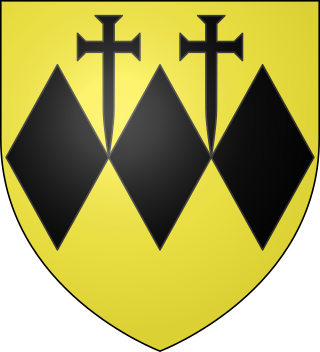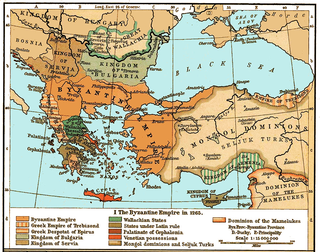Related Research Articles

The Duchy of the Archipelago, also known as Duchy of Naxos or Duchy of the Aegean, was a maritime state created by Venetian interests in the Cyclades archipelago in the Aegean Sea, in the aftermath of the Fourth Crusade, centered on the islands of Naxos and Paros. It included all the Cyclades. In 1537, it became a tributary of the Ottoman Empire, and was annexed by the Ottomans in 1579; however, Christian rule survived in islands such as Sifnos and Tinos.

William of Villehardouin was the fourth prince of Achaea in Frankish Greece, from 1246 to 1278. The younger son of Prince Geoffrey I, he held the Barony of Kalamata in fief during the reign of his elder brother Geoffrey II. William ruled Achaea as regent for his brother during Geoffrey's military campaigns against the Greeks of Nicaea, who were the principal enemies of his overlord, the Latin Emperor of Constantinople Baldwin II. William succeeded his childless brother in the summer of 1246. Conflicts between Nicaea and Epirus enabled him to complete the conquest of the Morea in about three years. He captured Monemvasia and built three new fortresses, forcing two previously autonomous tribes, the Tzakones and Melingoi, into submission. He participated in the unsuccessful Egyptian crusade of Louis IX of France, who rewarded him with the right to issue currency in the style of French royal coins.
During the late Middle Ages, the two cities of Argos and Nauplia formed a lordship within the Frankish-ruled Morea in southern Greece.

Karystos or Carystus is a small coastal town on the Greek island of Euboea. It has about 5,000 inhabitants. It lies 129 km south of Chalkis. From Athens it is accessible by ferry via Marmari from the port of Rafina. After the Greek war of independence, its urban plan was laid out by the renowned Bavarian civil engineer Bierbach, in the middle of the 19th century.

Geoffrey II of Villehardouin was the third prince of Achaea. From his accession to the princely throne, he was a powerful and respected person, and even French knights came to the principality to enter his service. Geoffrey II emerged as the most powerful vassal of the Latin Empire of Constantinople, the person around whom the crusaders' states in modern Greece gradually regrouped themselves. He came to the rescue of the imperial capital three times. As a reward of his services to the Latin Empire, he was granted suzerainty over the island of Euboea by his brother-in-law, Emperor Baldwin II of Constantinople (1228–1261). He was also a humane prince, benevolent and just, solicitous for the condition of the common people.

Othon de la Roche, also Otho de la Roche, was a Burgundian nobleman of the De la Roche family from La Roche-sur-l'Ognon. He joined the Fourth Crusade and became the first Frankish Lord of Athens in 1204. In addition to Athens, he acquired Thebes by around 1211.
Guy I de la Roche (1205–1263) was the Duke of Athens, the son and successor of the first duke Othon. After the conquest of Thebes, Othon gave half the city in lordship to Guy.

The War of the Euboeote Succession was fought in 1256–1258 between the Prince of Achaea, William of Villehardouin, and a broad coalition of other rulers from throughout Frankish Greece who felt threatened by William's aspirations. The war was sparked by Villehardouin's intervention in a succession dispute over the northern third of the island of Euboea, which was resisted by the local Lombard barons with the aid of the Republic of Venice. The Lord of Athens and Thebes, Guy I de la Roche, also entered the war against William, along with other barons of Central Greece. Their defeat at the Battle of Karydi in May/June 1258 effectively brought the war to an end in an Achaean victory, although a definite peace treaty was not concluded until 1262.
Licario, called Ikarios by the Greek chroniclers, was a Byzantine admiral of Italian origin in the 13th century. At odds with the Latin barons of his native Euboea, he entered the service of the Byzantine emperor Michael VIII Palaiologos, and reconquered many of the Aegean islands for him in the 1270s. For his exploits, he was rewarded with Euboea as a fief and rose to the rank of megas konostaulos and megas doux, the first foreigner to do so.

The Triarchy of Negroponte was a crusader state established on the island of Euboea after the partition of the Byzantine Empire following the Fourth Crusade. Partitioned into three baronies run by a few interrelated Lombard families, the island soon fell under the influence of the Republic of Venice. From circa 1390, the island became a regular Venetian colony as the Realm of Negroponte.

Boniface of Verona was a Lombard Crusader lord in Frankish Greece during the late 13th and early 14th century. A third son from a junior branch of his family, he sold his castle to equip himself as a knight, became a protégé of Guy II de la Roche, Duke of Athens, expelled the Byzantines from Euboea in 1296, and advanced to become one of the most powerful lords of Frankish Greece. Following Guy II's death, he served as regent for the Duchy of Athens in 1308–09, and was captured by the Catalan Company in the Battle of Halmyros in March 1311. The Catalans held Boniface in high regard, and offered to make him their leader. Boniface refused, but retained close relations with them, sharing their hostility towards the Republic of Venice and its own interests in Euboea. Boniface died in late 1317 or early 1318, leaving his son-in-law, the Catalan vicar-general Alfonso Fadrique, as the heir of his domains.

The Battle of Demetrias was a sea engagement fought at Volos in Greece in the early 1270s between a Byzantine fleet and the assembled forces of the Latin barons of Euboea (Negroponte) and Crete. The battle was fierce, and initially in favour of the Latins, but the timely arrival of Byzantine reinforcements tipped the scale, resulting in a crushing Byzantine victory.
Guy (II) of Dramelay was the third Baron of Chalandritsa in the Principality of Achaea in Frankish Greece, and also bailli of the Principality in 1282–85.
Bartholomew II Ghisi was a Latin feudal lord in medieval Greece, lord of Tinos and Mykonos, Triarch of Negroponte and Grand Constable of the Principality of Achaea.
Geoffrey of Briel, in older literature Geoffrey of Bruyères, was a French knight and the third lord of the Barony of Karytaina in the Principality of Achaea, in Frankish Greece. He led a colourful and turbulent life, narrated in detail in the Chronicle of the Morea. Accounted the finest knight in the Principality, he fought in the wars against the Byzantine Greeks, was captured in the Battle of Pelagonia in 1259, and was sent back to Achaea bearing the Byzantine terms in 1261. Geoffrey was twice deprived of his barony, once for rebelling against his uncle, the Prince of Achaea William II of Villehardouin, and then for abandoning the Principality without leave in order to spend time with a mistress, the wife of one of his feudatories, in Italy. He was pardoned both times, but henceforth held his title as a gift of the Prince. He died childless in 1275, and the Barony of Karytaina was split up.
William de la Roche was a Baron of Veligosti and Damala in the Principality of Achaea, and a relative of the ruling Dukes of Athens of the de la Roche family.
The First Parliament of Ravennika was convened in May 1209 by Latin Emperor Henry of Flanders in the town of Ravennika in Central Greece in an attempt to resolve the rebellion of the Lombard barons of the Kingdom of Thessalonica.
Geremia Ghisi was a Venetian nobleman who in c. 1207, following the Fourth Crusade, captured the Greek islands of Skiathos, Skopelos, and Skyros and became their lord, while his brother Andrea Ghisi conquered the islands of Tinos and Mykonos. Their sister or half-sister, Agnese Ghisi, married Othon de Cicon, who became the lord of Karystos on Euboea.
Agnese Ghisi, was Regent of Karystos in ca. 1266-69. She was a sister of Andrea Ghisi and Geremia Ghisi, and probably the wife of Othon de Cicon.
References
- ↑ Longnon 1973, p. 76.
- ↑ Setton 1976, pp. 417–418.
- 1 2 3 Longnon 1973, p. 77.
- ↑ Setton 1976, p. 418.
- ↑ Setton 1976, pp. 79–80.
- ↑ Setton 1976, p. 95.
- ↑ Setton 1976, pp. 80 (note 51), 418.
- ↑ Setton 1976, pp. 418, 426 (note 110).